

|
|
|
|
|
Our first region of interest was around Cape Town and the Cape of Good Hope: |
 |
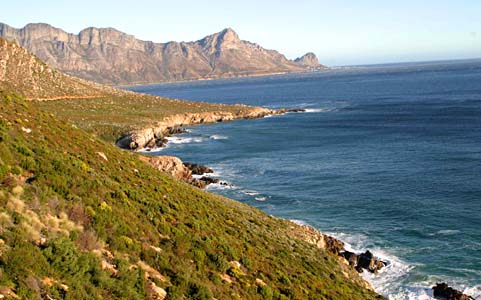 |
Beyond the life birds that represented new families that are highlighted on the first page of this report, our immediate priorities were the endemic birds of the Cape. We had excellent success with these in spectacular habitat: the view of Walker Bay (left) rivals views along our own Big Sur coast. Among the highlight species were Orange-breasted Sunbird (male; above), the skulking Cape Grassbird (below right), and this male Southern Double-collared Sunbird (below left) with tongue aquiver. |
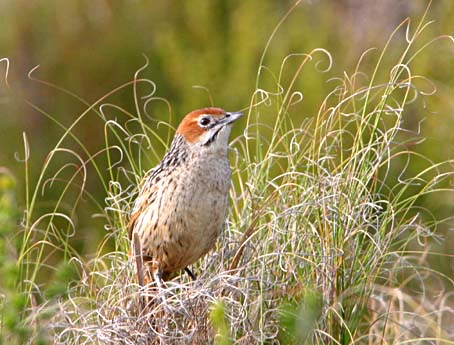 |
 |
|
During lunch the local information came in, so we drove back to Cape Town harbor and had a search for the sheathbill from the port's main jetty. It was blowing a gale and we had no luck. After the long plane flights (21 hours in the air) we were exhausted, so crashed at the City Lodge hotel by 4 pm. Day 2 (1 July): This day was our Great White Shark trip. A photo page will be up in due course. The van picked us up at 6:15 am and, after picking up 10 other passengers, we drove two hours to Gansbaai. After breakfast there we climbed aboard a small modified dive-boat for the half-hour trip to Dyer Island. Again, the wind was howling offshore but we anchored on the lee side where the seas were calm. We anchored here for 5 hours (as had 6 other small boats) and put out bait in hopes for sharks. It took a couple hours, but then the sharks got interested and we ended up seeing five huge Great White Sharks (2 male, 3 female). While waiting we enjoyed an assortment of seabirds, including both species of Giant Petrel that came to pick at the bait. Enroute back to Cape Town we got distant views of Southern Right Whales in Walker Bay. We didn't get back to the hotel until 7:30 pm (after dark) but we learned via phone that Richard had seen a sheathbill today, and that tomorrow's planned pelagic trip was canceled due to high winds.
Day 4 (3 July): We began this gloomy
overcast day at Jonker Dam, a spot the locals call "Black Hill," west of
Noordhoek. Walking trails here through fynbos habitat proved to be excellent,
especially as the day warmed up. Fynbos is a low, scrubby, succulent habitat
— vaguely recalling chaparral — but composed of native plants such as Protea.
It is the linchpin habitat of the Cape Floral Kingdom. As I understand
it, there are only six Floral Kingdoms on earth (e.g., all of North America
and Eurasia is in one Floral Kingdom), and the Cape Floral Kingdom is limited
to a small part of one country: South Africa. Over 8700 species of plants
are endemic to this tiny Kingdom. Bird highlights included Cape Grassbird,
Orange-breasted
& Southern Double-collared Sunbird,
Red-headed (Gray-backed)
Cisticola,
and Cape Siskin.
Day 5 (4 July): This was the day of Don's pelagic trip (see that link for full details). Rita chose not to do the pelagic but, instead, was able to arrange a ride to Cape Town and then a visit by ferry to Robben Island, where Nelson Mandela was imprisoned during the apartheid years. We celebrated all our successes with a superb dinner at the Southern Right Hotel in Glen Cairn, washed down with an excellent Fat Bastard Chardonnay. Day 6 (5 June): An early morning
visit to a local spot in the Constancia greenbelt eventually netted outstanding
(almost unbelievable) views of the very secretive Knysna Warbler.
We then headed north up the coast toward Lamberts Bay, stopping to bird
the Tienie Versveld Wildflower Reserve (Cloud Cisticola in display,
Thick-billed Lark) and West Coast Nat'l Park. The latter is a vast
expanse of dunes with fynbos scrub in the inter dune valleys, and a huge
lagoon with flamingos. A small pond off a side road yielded good views
of African Rail and Karoo Lark, plus the first of a dozen
Angulate Tortoises. We got only a distant view of Black Harrier,
but at the north entrance gate area had startling close encounters with
Black
Bustard.
|
 |
 |
|
In the arid, cold desert we searched for the Karoo specialties and took our first (and most successful) night drive: |
 |
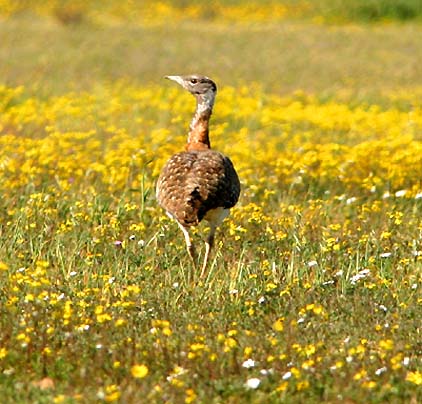 |
Striding among the wildflowers at Nieuwoutville Reserve was a much-wanted Ludwig's Bustard (left). This is a big bustard, second only to Kori Bustard in size on the trip. In the karoo around Brandvlei we found the Red Lark (below left) and that night had the unbelievable good luck to come upon an Aardvark (below right)! |
 |
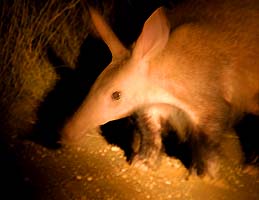 |
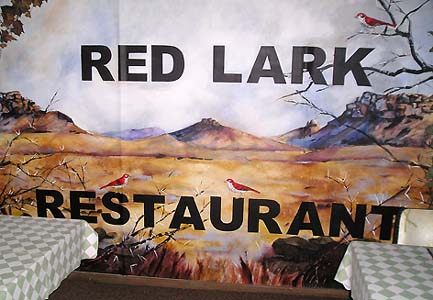
Day 8 (7 July): Brandvlei is in the middle of nowhere, and out here in the middle of nowhere are many species of endemic larks. Even the motel restaurant (right) promoted the idea of seeing my most wanted lark. So it was at dawn this day we found ourselves 10 km or so outside town, in the smack dab middle of no where, and there was a Red Lark in display flight above us! We would record 6 lark species today, plus a host of other karoo specialties (e.g., Karoo, Sickle-winged & Tractrac chats). Karoo Bustard, Karoo Prinia, Karoo Thrush (recent split from Olive) were all recorded. We also headed out the dirt roads after dark on our own night drive. Cape Fox and Cape Hare were spotted, and we stopped to marvel at the plethora of stars out here where no lights interfere. It was shortly thereafter when, unbelievably, an Aardvark ambled into the road. We stopped and kept the spotlight on it as it headed straight for us. Rita shot video during the entire 3-5 minute encounter. Aardvark is one of the most difficult African mammals to see; it has incredible hearing and is very shy. Even Adam Riley — who runs Rockjumper Tours and is constantly on tour in Africa — has never seen one. It was the single high-point of the entire trip. Day 9 (8 July): Today was mostly a travel day from Brandvlei to Augrabies Falls NP, via Kenhardt and Keimos (lunch). Of course we stopped when birds were spotted. New species today included our first Social Weavers and their incredible nests and, as we ventured into drier country more Kalahari in influence than karoo, our first Pririt Batis and Dusky Sunbird, and our first Martial Eagle, sitting calmly on a pole for photos. We reached Augrabies Falls Nat'l Park by mid-afternoon and immediately took in the grandeur of the falls (photos below). The literature says that the name of the falls comes from the Namaqua word for "place of great noise." Here the Orange River has gauged out an 18 km canyon through granite. At the top of the canyon is Augrabies Falls, which drop 56m (in comparison, Yosemite's Bridalveil Falls is a 75m drop). The entire Orange River narrows to go over the falls (much as does the White Nile at Murchison in Uganda). While Murchison and Victoria, Yosemite and Niagara and Angel, may be the world's most famous falls, this is certainly in the world's 'top ten' waterfalls. And I'd never heard of them before! Day 10 (9 July): All day in Augrabies Falls NP. The park is famous not only for the falls but for the riverine/desert ecology here. We had close encounters with Klipspringers and baboons and many Rock Hyrax. Birding was also good, although we dipped on our various efforts to call up a Cinnamon-breasted Warbler. Some of the interesting birds here including Alpine Swift, the newly-split Orange River White-eye, and the very local Namaqua Warbler. It also turns out that the colorful rock lizards on the cliffs are the newly-split Rowley's Flat Lizard, endemic to this short stretch of the Orange River canyon. |
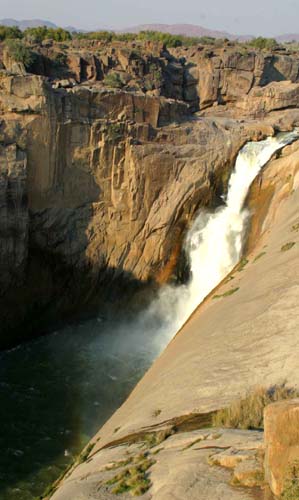 |
 |
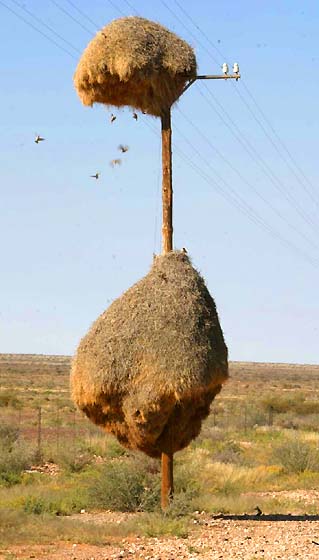 |
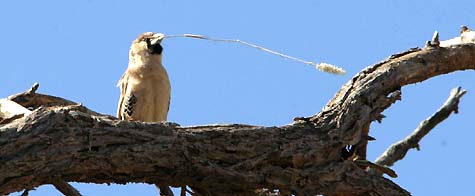
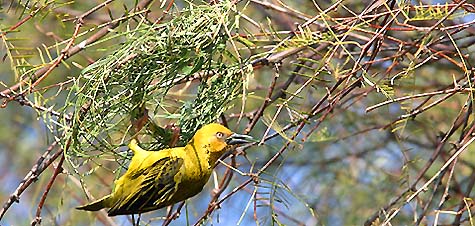
We also enjoyed many more widespread endemics or near-endemics. Especially fascinating were the weavers. Social Weaver (above top, with grass stem) builds these humungous nests of grass on telephone poles or dead trees; sometimes they get so heavy that they topple the pole! The weavers are busy going in and out (left), making it look like the nests are 'dripping' birds. Cape Weaver (just above) weaves a much smaller nest; this white-eyed male had just started the nest ring. |
|
|
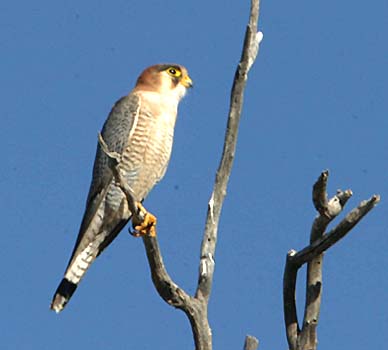 |
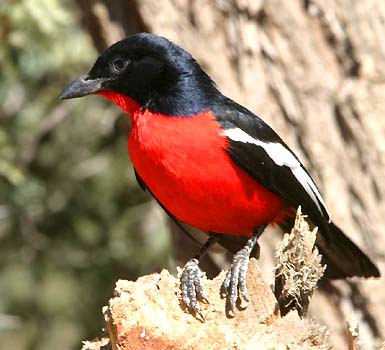 |
| Among the many raptors in the Kalahari, none were more striking than Red-necked Falcon (above left). Crimson-breasted Gonolek (above right) really brightened up the scenery in small thickets near water. The desert was full of small flocks of Scaly Weaver. It is a lovely little bird (right) whose Afrikaner name is "Baardmannetjie," pronounced something like "butmankajee," meaning "bearded little man." So Don, doing his best Bart Simpson imitation, and to the constant annoyance of the everyone else, consistently called it a "butt monkey" thereafter, except for the times he proposed "angry bearded gnome" as a translation. |
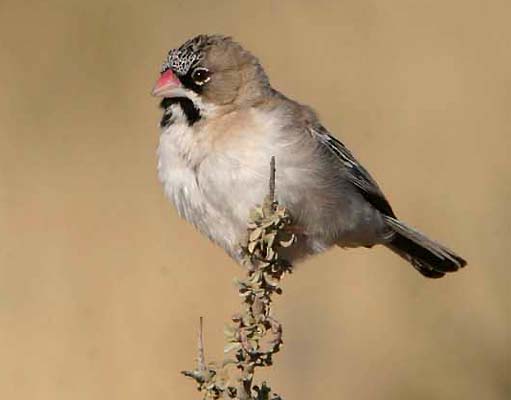 |
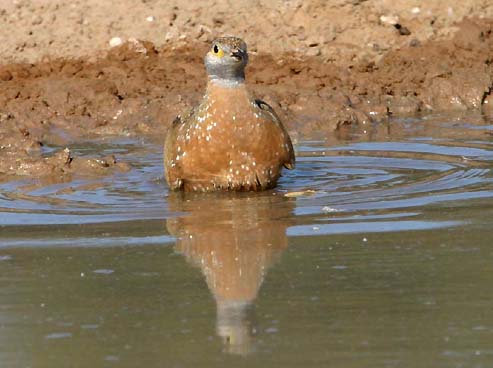 |
Over the course of a day a plethora of birds and mammals visit each small waterhole in the park. Some species of sandgrouse visit only at dawn or dusk, but we saw our single party of Burchell's Sandgrouse (male in the waterhole; left) at mid-day (he stayed only a few seconds . . . just enough for one shot). We saw a surprising number of battles between male wildebeest (below left) and daily close-ups of Springbok (male; below right). |
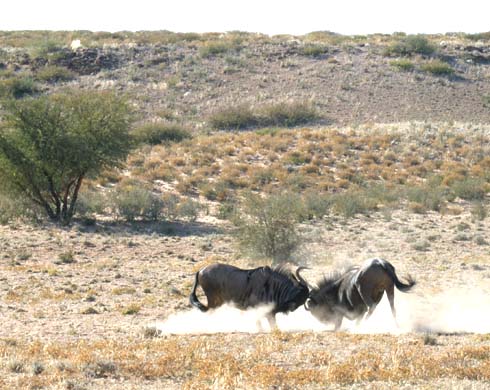 |
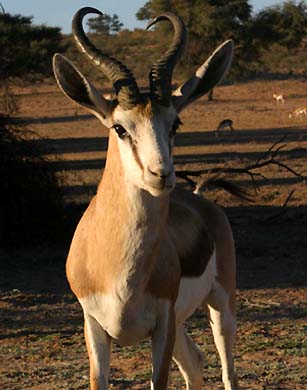 |
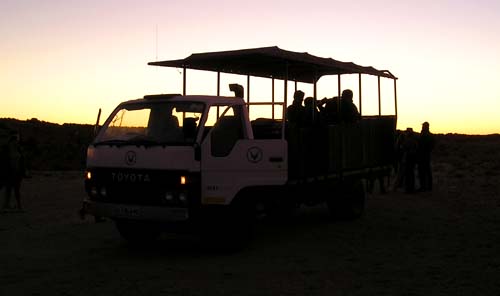 Day
11 (10 July): This was a long travel day from Augrabies Falls
to the Kalahari-Gemsbok Nat'l Park. While we had good paved roads on many
of our longest drives, the final 90 km of this route was a very dusty,
deep-rutted dirt road that is heavily used by larger vehicles. It turned
out that dust poured into our Honda from below at speed on dirt roads.
By day's end everything in the trunk, and everything in the car (meaning
us), were covered with a fine layer of reddish dirt. Sitting in the back
seat was a literal 'black hole' which Rita survived only by listening to
a book-on-tape through ear-phones. Adam Riley happened to telephone Richard's
cell phone just as we arrived in late afternoon, and we were not happy
campers. [Rockjumper Tours decided the situation was unacceptable, and
advised that we would switch cars at Windhoek. They would rent us a new
car — this was very good news. We had to deal with the Kalahari dust for
the rest of this week but an end to it was in sight.] Day
11 (10 July): This was a long travel day from Augrabies Falls
to the Kalahari-Gemsbok Nat'l Park. While we had good paved roads on many
of our longest drives, the final 90 km of this route was a very dusty,
deep-rutted dirt road that is heavily used by larger vehicles. It turned
out that dust poured into our Honda from below at speed on dirt roads.
By day's end everything in the trunk, and everything in the car (meaning
us), were covered with a fine layer of reddish dirt. Sitting in the back
seat was a literal 'black hole' which Rita survived only by listening to
a book-on-tape through ear-phones. Adam Riley happened to telephone Richard's
cell phone just as we arrived in late afternoon, and we were not happy
campers. [Rockjumper Tours decided the situation was unacceptable, and
advised that we would switch cars at Windhoek. They would rent us a new
car — this was very good news. We had to deal with the Kalahari dust for
the rest of this week but an end to it was in sight.]
The best part of this day was a night drive in the park service vehicle (right). It was an open-air truckbed, and very cold at night, but they provided lots of thick blankets. We were astounded by the sheer numbers of birds and mammals spotted from the dirt track at night: Spotted & Giant Eagle-Owl, and a Southern White-faced Owl; Springhares and Bat-eared Foxes, several Wild Cats and a Porcupine, and to top them all: good views of an Aardwolf! Day 12 (11 July): We had spent the night in bungalows at Twee Rivieren, at the southern entrance to the park. Today we made the long, slow drive to Mata Mata, at the northern tip of the park. The road parallels a dry riverbed much of the way, and scattered herds of Gemsbok, Springbok, Blue Wildebeest, and scattered Steenbok graced the route. We stopped numerous times to watch mammals or photograph desert birds. Raptors were numerous, including Bateleur, Booted Eagle, Jackal Buzzard, and the very common Pale Chanting-Goshawk. We found several Pygmy Falcon at or near Social Weaver nests. Day 13 (12 July): In the morning we tried various dirt tracks out of Mata Mata, coming upon Red-necked and Lanner Falcons, and our first Pearl-spotted Owlet of the trip (we would actually see over a dozen on the trip). Mammals seemed a bit sparse but we did observe some Meercats (but they were too skittish to photograph). In the afternoon we hung around Mata Mata, doing laundry by hand and stalking the tame birds coming to a little water drip inside the camp (including the Crimson-breasted Gonolek shown above). The nights here were exceedingly cold, and there wasn't much heat available in the rooms. Day 14 (13 July): This day was the
long, slow drive back from Mata Mata to Twee Rivieren, stopping as we happened
to find birds or mammals of interest. We had most of the Kalahari birds
by now, but Burchell's Sandgrouse was new at mid-day.
Day 15 (14 July): We knew that this
and next two days were all long travel days. This is vast country and it
would take many hours of driving — usually on fast tarred roads — to traverse
southern Namibia. The worst stretch was the first 90 km out of Kalahari-Gemsbok
NP, but it seemed less awful early in the morning than it had in the afternoon
four days before. We had lunch in Upington, a prosperous town with a big
shopping center, and even found an Internet cafe to check email. Then it
was the long drive to Canyon Lodge (near Fish River Canyon in s. Namibia),
once we had gone through the formalities at the South Africa-Namibia border.
Day 16 (15 July): We visited Fish River Canyon early in the morning. It is said to be the world's second largest canyon, after Arizona's Grand Canyon. It is desolate and barren and impressive (see photo below). We then continued north to Mariental (about 2/3 the way to Windhoek) and then a bit east to Anib Lodge for the night. The food and hospitality here were very good. We did our final night drive on the Lodge's property. They'd reintroduced many antelope in Kalahari-like dune habitat. Part of the package was a nice 'Sundowner' drink atop a dune as the sun sank into the desert. Day 17 (16 July): It was a comparatively
short 3-hour drive from Anib Lodge to Windhoek on paved roads, getting
us to Namibia's capital by mid-day. Windhoek proved to be a very European
city, and we had lunch in a balcony cafe that would have been at home in
Paris or Amsterdam. Did a bit of shopping and Internet, and checked into
Tamboti Lodge near downtown.
|
 |
|
|
|
|
|
|
|
|
|
of MAMMALS for the July 2005 trip |
|
|
PHOTOS: All photos on this page are © 2005 Don Roberson; all rights reserved. Many other shots from this trip are scattered about this web site. Check particularly bird families, mammals, and herps listings.
Literature cited:
Beresford, P., F.K. Barker, P.G. Ryan, and T.M. Crowe. 2005. African endemics span the tree of songbirds (Passeri): molecular systematics of several evolutionary 'enigmas'. Proc. R. Soc. B 272: 849-858.TOPDickinson, E., ed. 2003. The Howard & Moore Complete Checklist of the Birds of the World. 3d ed. Princeton Univ. Press, Princeton, N.J.
Sinclair, I., P. Hockey, and W. Tarboton. 1993. Illustrated Guide to the Birds of Southern Africa. New Holland, London.
GO TO LIST OF BIRD FAMILIES OF THE WORLD